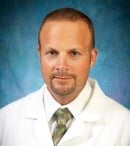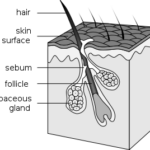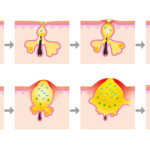
Acne is one of the most common diagnoses I deal with on a daily basis. There are a lot of acne recommendations utilizing over the counter(OTC) therapies, as well as prescription medications. The course of discussion for this post is going to understanding the causes and science of the development of acne. This will help to then understand, and hopefully influence, choices we make in the therapies we use. So everyone needs to brace yourself and hang on for the science lesson. Fortunately there will not be a test afterwards.

Acne begins as a lesion called a microcomedone. This is the precursor to all other lesions we see. Our skin cells called keratinocytes become extra sticky causing adherence at the opening of our oil glands on the face and back, the fancy medical term is the pilosebaceous unit (see figure 1), when this stickiness occurs it prevents oil from the gland from reaching the surface of the skin. When this oil builds up it causes the microcomedone. When these pores are open, it exposes the oil to oxidative factors creating a black head, if the opening stays closed it creates a whitehead. With continued blockage of the pore increased, amounts of oil fill the pore. Bacteria called Propionibacterium acnes (P. Acnes) occupy the pore digesting the oil as it is produced. With increased oil production it is also an increase in food source causing increased colonies of bacteria to develop. As the bacteria digest the oil it excretes a product called free fatty acids, bacteria poo, that causes an inflammatory reaction and white blood cell aggregation into the pore causing a pustule to develop. Hormones also play an important role in the develop of active acne lesions. Androgens and testosterone, in particular, increase oil production in the pore. That is the reason acne is worse in adolescence compared to adulthood. Diet is also an important player in acne development with increased consumption of processed carbohydrates and sugars the body releases insulin that causes increases in hormone production. With the increasing oil production and free fatty acid release, inflammation significantly increases

causing the progression from a microcomedone to close or open, come down to a papule, to pustule, to nodule, and then cysts which lead to endpoint scarring. (see fiqure 2).
Science lesson is now complete; everyone can now take a breath, and hopefully having absorbed the above information we can break down the utility of current therapies. Therapies are typically directed at the primary lesions. All acne starts as a microcomedone and that is where the topical creams come into play; most of the creams available on the market are effective at reducing skin stickiness. If creams are used as directed and consistently, most progression of acne can be averted. Once the acne becomes inflamed and pores are thoroughly plugged that is when addition of antibiotics becomes necessary. Most antibiotics are anti-inflammatory and help to reduce bacterial colonies. Hormone control can be accomplished with birth-control pills for females and dietary modifications.
Topical therapy is probably the most common type of treatment and the most readily accessible. Watch an infomercial or commercial about the latest and greatest acne treatment available without prescription and it will most likely be a topical therapy. The most common ingredient used is benzoyl peroxide. Benzoyl peroxide is a very effective keratolytic or skin stickiness reducer. It is also a very effective topical antibiotic. Coming soon to the marketplace is going to be a product using adapalene as the main ingredient. Adapalene is a retinoid that is also a powerful keratolytic. Combinations of these two products are probably one of the most effective topical therapies on the market today.
Washes are an interesting topic of discussion when I discuss topical therapy. I personally do not consider washes an important part of acne therapy. I recommend just any mild cleanser or soap. I do not recommend any astringents, scrubs, brushes or abrasive cleansers. Washes are short contact products used just for cleansing and then rinsing off. I feel you get just as clean using a bar of Dove soap as you do with an expensive cleanser and depending on the abrasiveness of the cleanser may irritate the skin and counteract the effectiveness and tolerability of topical product. Using a wash is like saying I have a headache so I am going to lick an ibuprofen tablet and throw it away, yes you were exposed to the medicine but you got rid of it before it could give you any real benefit.
When acne has progressed to inflammatory lesions, like a papules and pustules, it is most likely only going to be controlled with oral medication and a prescription is going to be necessary. Then it is time to come see me or one of my colleagues. Hope this was helpful, looking forward to some engaging conversation, let me know what questions you may have.
Jason Cheyney, MPAS, PA-C is a Skin, Bones, Hearts & Private Parts speaker. You can see him in Orlando (April), Myrtle Beach, San Antonio, and Las Vegas in 2017.